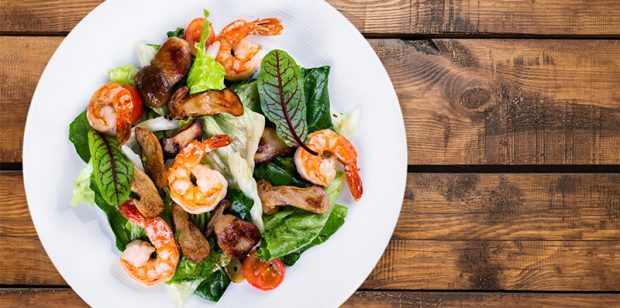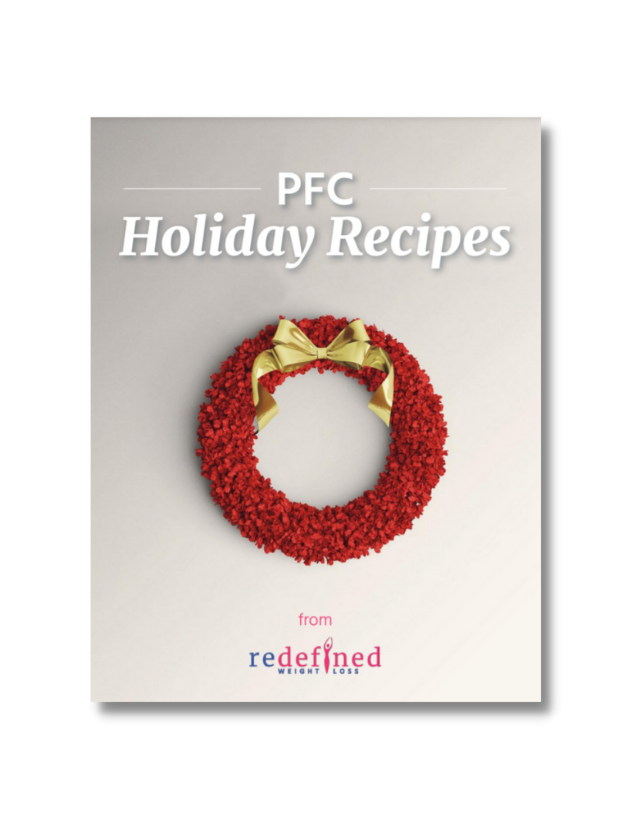Whether you’ve been following me for a day or a year, you’ve probably noticed that I’ve coined the acronym PFC to refer to the way I believe most of us should be eating. This post is to give you a clear understanding of what PFC means, how following my simple PFC guidelines will benefit your health, energy levels and waistline, and what it looks like to eat this way.
Your Guide to PFC Balanced Eating:
What is PFC? There are three macronutrient categories that every food falls into: protein, fat, or carbohydrate. Many diets focus on restricting or completely eliminating a macronutrient, but the truth is: your body needs and works best when it has them all. We’ll dive into each macronutrient deeper, but in general, your proteins are meat, fish and eggs, fats are olive oil, coconut oil, butter, nuts, seeds, olives, avocados and coconut milk, and carbs are fruits and veggies.
Why do we need all 3? Well, the short answer is that the best way to support your metabolism (and, by extension, your waistline) is to consume all three—proteins, fats and carbohydrates—together, in balance. The three macronutrients, protein, fat and carbohydrates, are processed very differently in the body, and each support the body, brain and metabolism in their own unique way. Protein is a building block for many of our neurotransmitters (brain chemicals) and has the ability to increase our metabolism. Fat supports brain function, keeps us full and acts as a buffer for carbohydrates by slowing down their assimilation into our blood stream. Carbohydrates give us quick energy because they have the greatest effect on raising blood sugar levels. The best way to support metabolism and brain function is by consuming all three macronutrients together.
How do you determine which category a food falls into? While many foods overlap into two or all three categories, for simplicity’s sake, it’s easiest to designate a food as a protein, fat, or carb based on whichever macro it contains most of.
Also keep in mind that the protein choices that support metabolism most are animal products, like meat, fish and eggs. Therefore, I count foods like peanut butter or cheese, (both of which contain fat AND protein) as fats — not only do they have more fat than protein, but they aren’t proteins that support metabolism the most. When in doubt, count it as whichever category it has most of and don’t stress about it too much! For example, the jar of peanut butter in my fridge says that, per serving, it contains seven grams of protein, seven grams of carbs, and seventeen grams of fat. Therefore, it counts as a fat. Pretty easy.
How does PFC compare to SAD? The Standard American Diet (SAD) is an eating regimen consisting of a high amount of refined carbohydrates, refined oils and trans fats, low to moderate protein consumption and minimal healthy fat. The SAD is a disaster when it comes to keeping blood sugar levels stable. Carbohydrates, the macronutrient consumed most when following the SAD, are also the macronutrient that contributes to the greatest highs and lows in blood sugars. Consuming carbs with little to no fat (which acts as a buffer and minimizes the potentially damaging effect of carbs) sets you up for a ride on the blood sugar roller coaster. While it’s fun for a few minutes at an amusement park, when it comes to everyday living, riding the blood sugar roller coaster day in and day out is exhausting. It depletes you of energy, focus, and sets you up for weight gain. It’s no way to live. You know you’ve been for a ride when you’re constantly fighting sugar cravings, having trouble focusing, struggling to fall and/or staying asleep, experiencing mood swings, staving off low energy levels and battling with undesired weight gain or having trouble losing weight. Sound familiar?
Why eat the PFC way? We get off the blood sugar roller coaster by having protein and healthy fat with our carbs, every time we eat. “PFC Every Three” is the key to keeping you off the roller coaster because it keeps your blood sugar levels steady. And steady blood sugars (i.e. blood sugar regulation) is the underlying key to great energy levels, positive moods, crystal clear focus, a boosted metabolism, and no more sugar cravings. You can stabilize your blood sugars when eating in balance by incorporating healthy fat, quality protein and nutrient-dense carbohydrates every time you eat. When blood sugar levels are too high or too low, we are sure to experience consequences like increased blood pressure, inflammation, anxiety, insomnia, mood swings and more. To stabilize blood sugar levels, strive to eat protein, fat and carbs every three hours (four hours MAX!) to keep blood sugar levels balance— that’s “PFC Every Three.”
How does PFC help with weight loss? Here’s how it works: Carbohydrates cause your fat-storing hormone, insulin, to be released and store those carbs as fat. Fat and protein, on the other hand, aren’t metabolized as sugar. They act as buffers, slowing down the absorption of sugar into your bloodstream and, in turn, help to keep your blood sugar levels stable. Again, when your blood sugars are stable, that wonderful fat-burning hormone, glucagon, is released, which burns stored fat for energy. Glucagon can’t do its fat-burning, metabolism-boosting job if insulin, that fat-storing hormone of yours is at work. Get on glucagon’s good side by eating more butter and bacon, thus giving glucagon a chance to shine. You come out ahead too, because when your glucagon is rocking and rolling, so are you! You become a fat- burning machine with more energy and a better chance at shedding the pounds.
Do I need to count anything? I don’t recommend counting points, calories, grams or anything else, but it is important to be aware of portion sizes. Each person’s ideal portion size of protein, fat and carbohydrates is dependent on their weight, goals and activity level. That being said, it’s important to consume all three each time you eat.
- Protein: A good rule of thumb is to aim for eating a portion of protein equivalent to the thickness and circumference of the palm of your hand at meals (2-3 eggs, 4-6 oz. of chicken, beef, or fish) and about half that amount at snacks.
- Fat: For most people, I encourage having a MINIMUM of 1-2 servings of fat at every meal and snack (one serving equals half an avocado, an ounce of cheese, 1 Tablespoon of butter, coconut or olive oil, 2 Tablespoons of nut butter, ¼ cup coconut milk, 2 Tablespoons heavy cream, etc.).
- Carbs: For most people I recommend choosing non-starchy vegetables like broccoli, cauliflower, spinach and cucumbers first. These vegetables don’t affect your blood sugar levels nearly as much and they provide loads of antioxidants, vitamins, minerals, and fiber. Fill up on these first (shoot for a couple cups at each meal!) and limit the starchier veggies like potatoes, carrots, squash, corn, and fruit to about a half cup at a time to help prevent blood sugar spikes.
3 Additional points worth mentioning:
1) Never eat a carbohydrate alone. The problem with eating any carbohydrate alone is that because all carbohydrates turn to sugar once they reach the blood stream, they spike your blood sugar levels. This sets your body up for cravings and binges, irritability, lack of focus and weight gain. When we eat carbs, we do not receive a message to stop eating until our stomachs are physically stretched and full. When we eat fats, our brain receives a hormonal message (cholecystokinin) telling you to stop eating. Remember that fats help slow the digestion of carbs, which causes a more gradual increase in blood sugar instead of a spike. If you’re in a pinch and cannot find all three PFC, opt for two out of three and try to find a protein or fat source to go with your carbs to soften the effect the carbs have on your blood sugar levels. Read this post for more on this.
2) It’s NOT about perfection. As much as I dislike counting calories or points, I dislike getting too nitty-gritty about eating. Keep the focus on real food in balance and learn to listen to your body. Make connections by noticing how different foods affect your mood, energy levels and cravings and pay attention to how you feel when you leave out a macronutrient. My clients love how this way of eating is very forgiving: Even when you aren’t perfect, you’ll still feel great.
3) Timing matters. It’s not just about what you eat, but also when you eat that is important. I’ve found for both myself and the thousands of clients we’ve worked with that having a P, F and C every three to four hours—starting within an hour of waking, all the way up until you lay your head on the pillow at night—is the best way to support overall blood sugar balance and weight loss. This could sound overwhelming if you’re used to only eating three meals a day, but it doesn’t necessarily mean you’re eating more food overall. Eating snacks between your meals often results in reduced hunger at mealtimes, so you tend to eat smaller portions. That’s because it boosts your metabolism by keeping your blood sugar levels stable. This also lowers your levels of your fat-storing hormone, insulin and supports the release of your fat-burning hormone, glucagon, and in turn, weight loss.
Snacking between your meals is a great preventative measure to stay off the blood sugar roller coaster. When you don’t snack, your body learns to live in “starvation mode,” and your metabolism slows down as your body adjusts and compensates. Your body then hangs onto extra energy at meals by turning it into fat because it’s expecting that it will need that fat in case you don’t eat for a while again. Snack on protein, healthy fat, and vegetable and fruit carbohydrates every few hours to keep your metabolism high and to stay in fat-burning mode.
Now before you check out PFC Balanced Eating Part 2: The Components, I would love to invite you to our FREE online Facebook Community, A New Way To Weight Loss! This group is all about helping helping people like you stop the vicious dieting cycle, end the obsession over food and lose weight effortlessly—while enjoying what you eat, and feeling like your happy, confident self again. This as a community where we can connect and support each other and have a conversation with you about your weight loss goals. Click here to join A New Way To Weight Loss!













Love it!
Hi Dietitian Cassie- just found your site today. I’ve read a few Paleo books and did it for a few months last year (and lost a bit of weight, but then got pregnant and could only manage CARBS!) Now 4 months postpartum and looking to lose the baby fat, I’m researching Paleo vs Real food. I appreciate that your approach is more moderate. Here’s my question regarding weight loss with your method: It seems to me that we will store all the fat we eat with carbs– the only way to burn fat is to be in a ketogenic state (correct me if I’m wrong) and to have insulin out of the equation. Sure, fat will slow down absorption of glucose and minimize the insulin spike, but its very presence will continue to impede glucagon and mobilization of fat stores. So to truly lose fat, don’t we need to be carb- free (which is SO hard for me)?
Hi! Thanks for the comment and for appreciating my moderate PFC approach 🙂 Good question regarding weight loss. I disagree and know for a fact from experience! that the body does not need to be in a ketogenic state in order to burn fat. We actually don’t support or guide our clients through ketosis, and instead focus on maintaining balance in all areas: balanced blood sugar levels, balanced hormones, balance with sleep, stress, exercise, etc. So to answer your question, to truly lose fat, NO, one does not need to be carb-free (yipee, right!?). Myself or one of our coaches would love to help you in a coaching appointment u2014 where we look at the big picture and individualize everything to make this way of living work for you. For more info just email [email protected] 🙂